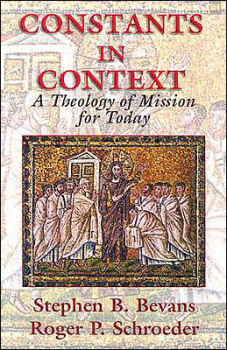
|
Posted February 16, 2006
An Excellent Book to be Read with the Latest Study on International Priests “International Priests in America: Challenges and Opportunities” listed on our home page of books. Book: Constants in Context: A Theology of Mission for Today Authors: Stephen R. Bevans and Roger P.Schroeder Orbis, Maryknoll, NY, 2004, pp. 488 An Excerpt from the Introduction:
An Excerpt from the Book: Stephen Bevans has suggested that a spirituality of inculturation is needed to guide Christians through the heady but difficult task of allowing Christian faith and local contexts to encounter one another authentically. He calls this a spirituality of “letting go” and “speaking out,” and it is one that functions differently for “outsiders” and “insiders.” For outsiders, the main spiritual task in the inculturation process is letting go – of superiority, of power, of illusions that they understand of a culture, of illusions that theirs is the true understanding of Christianity. Only after years of listening, learning and being evangelized by the context in which they live as strangers and guests might they dare speak out with suggestions for inculturation or with critiques of the context. For insiders, in contrast, the main spiritual task is to speak out – to have confidence in themselves and in their own understandings of their cultural and/or social context, and to risk ways of encounter between gospel and context. Only very slowly should they heed criticism of their culture and let go of their intuitions and instincts. It is, again, in such prophetic dialogue that local communities and their leadership – whether insiders or outsiders – will discover new ways of living, witnessing to and proclaiming the good news of healing, reconciliation and new life. Inculturation is certainly an exercise in prophetic dialogue. It needs, first of all, to be profoundly dialogical, because a context is not always easily readable on the surface. Years of listening, years of learning from a culture’s traditions, the hard work of conversing with both grassroots people and academic studies – these are all essential for both insiders and outsiders in any pastoral situation. At the same time, not everything in a culture is good; some things might even need to be denounced as evil and eradicated from a culture. Experience must be honored, but biases can distort perceptions as well. The gospel finds resonances and obstacles in every context. Ironically, says Darrell Whiteman, “good contextualization offends. Table of Contents: Part I Constants in Context: Biblical and Theological Foundations 1. “Missionary by its very nature”: Context and the Church’s Mission 2. “You are witnesses of these things: Constants in the Church’s Mission Part II Constants in Context: Historical Models of Mission 3. Mission in the Early Church (100-301) Individual Christians in a Variety of Situations 4. Mission and the Monastic Movement (313-907) From Constantine to the Decline of the T’ang Dynasty 5. Mission and the Mendicant Movement (1000-1453) Crusades, Preachers, Nuns and Mongolian Christianity 6. Mission in the Age of Discovery (1492-1773)Conquistadors, Prophets and Gurus 7. Mission in the Age of Progess (1792-1914) Civilizers, Evangelists and Volunteer Societies 8. Mission in the Twentieth Century (1919-1991) The Emergence of World Christianity Part III Constants in Context: A Theology of Mission for Today 9. Mission as Participation in the Mission of the Triune God (Missio Dei) 10. Mission as Liberating Service of the Reign of God 11. Mission as Proclamation of Jesus Christ as Universal Savior 12. Mission as Prophetic Dialogue Concluding Reflections: On being constant in today’s context |
|
